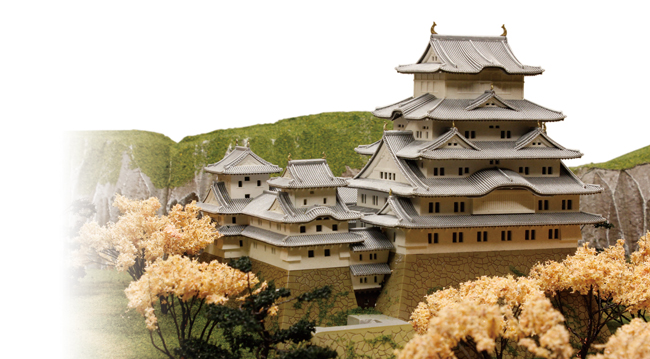
当たり前に日本人として生きてきた。でも海外に出てから、日本について何も知らないことに気が付いた。そこで、日本が世界に誇る世界遺産について建立年順に勉強しようと思う。興味がある人も、そうでない人も、しばしお付き合いを。
I’ve lived my whole life as a Japanese person, but when I went overseas I realised I know practically nothing about Japan. So now I’m learning about Japan’s World Heritage Sites, from oldest to newest. Those who are interested, and even those who are not, come along for the ride.

撮影協力 / メルボルン総領事館 Thanks to the Consulate-General of Japan, Melbourne
○○○○○ 姫路城 孤城落日を乗り越え、優美な姿を今に伝える名城 ○○○○○
今回は、1993年に奈良県の法隆寺と共に日本で初めて世界文化遺産に登録された、兵庫県の姫路城を紹介します。姫路城は、“木造建築物としては、建物の配置が良く、美的にも優れた建造物であること”、“17世紀初頭の日本独自の城郭建築(じょうかくけんちく)の特徴を最もよく示し、建造物が良好に保存されていること”などが評価され、世界文化遺産に登録されました。
姫路城の特徴は、なんといっても白い城壁。その美しい姿から「白鷺城(はくろじょう・しらさぎじょう)」とも呼ばれています。この呼び名に関しては、黒い板張りの岡山城、烏城(うじょう)と対比したという説や、白鷺が多く住んでいたという説などがあります。しかし、どうして白なのか? と疑問に思った方もいるのでは。その理由も探りつつ、姫路城の歴史を振り返ってみたい思います。
姫路城の歴史は、皇室が南北2つに分裂した南北朝時代(1336-1392年)にまで遡ります。兵庫県南西部を領土とする大名 赤松 貞範(あかまつ さだのり)が1346年に姫山に築城したのが始まりで、当時は姫山城と呼び、天守や石垣がない小さな山城でした。その後、戦国時代に姫山城主であった黒田 孝高(くろだ よしたか)が「中国攻略の拠点に」と、城を羽柴 秀吉(はしば ひでよし:後の豊臣 秀吉)に献上。その際、姫山城は姫路城に改名され、3層の天守閣や石垣が建造されました。現在の姫路城の基礎は、秀吉の死後、姫路城に入城した池田 輝政(いけだ てるまさ)による大改築で、9年の歳月を掛けて行われました。この時に、防水や瓦留め、火縄銃の射撃によって延焼しないよう、防火・耐火にも優れた白漆喰総塗籠造(しろしっくいそうぬりごめづくり)が採用されました。優雅な外観とは裏腹に、城の中に一歩足を踏み入れると、敵を簡単に天守に近付けない迷路のような縄張り(道順)、待ち伏せや挟み撃ちなどの罠が至る所に張り巡らされています。美しさの裏に、本来の目的である戦いのための真の姿が隠されている城郭建築の特徴ですね。
ところが、城の維持費に巨額の経費が掛かり藩の経済を圧迫していきます。そして明治時代の廃藩置県により無用の長物となった各地の城は、廃城の嵐に晒されることになります。姫路城も例外ではなく競売に掛けられ、たったの23円50銭(現在だと約10万円)!! で一市民に落札されてしまいます。 しかし、どういう経緯か陸軍に買い戻され解体を免れることに。無用の長物から世界に誇る日本の宝に…時代によって物の存在価値ってこんなに変わるものなんですね。戦時中には、攻撃目標とされるのを少しでも防ぐために、黒の防御網でカモフラージュされたそうですが、大空襲に見舞われ、城の天守にも焼夷弾が直撃します。幸運にも不発で、焼失を免れました。築城されてから大規模な戦火にさらされることが一度もなく、甚大な被害を被ることがなかったことから、不戦の城とも呼ばれています。2015年に平成の修理を終え、真っ白な姿になりました。でもこの白さは、カビや浸食で数年で徐々に失われてしまうそうですよ。
また、姫路城には怪談話の定番『播州皿屋敷(ばんしゅうさらやしき)』のお菊井戸や宮本 武蔵(みやもと むさし)の妖怪退治伝説など興味深い逸話が残っています。
次回は、古都京都の文化財として登録されている 銀閣寺をご紹介します。
○○○Himeji Castle: a famous castle both elegant and functional ○○○
This time, we introduce Hyogo Prefecture’s Himeji Castle, which in 1993 (along with Nara Prefecture’s Horyu-ji) was one of the first sites in Japan to be added to the World Heritage register. It is considered to be the ‘finest surviving example of early 17th-century Japanese castle architecture,’ with beautiful, well-arranged wooden structures in an excellent state of preservation.
The most obvious distinguishing feature of Himeji Castle is its beautiful white walls. It is also known as the ‘White Heron Castle,’ this may be because many white herons lived there, or perhaps to contrast it with the black wooden boarded Okayama Castle, known as the ‘Crow Castle.’ But some of you may be wondering: why is Himeji Castle white? Let’s take a look back through the building’s history to find out.
The history of Himeji Castle dates back to the Nanboku-cho period (1336-1392), when there was both a Northern and a Southern Imperial Court. It started when Akamatsu Sadanori, a daimyo who ruled over southwest Hyogo Prefecture, started constructing a castle on Himeyama hill; at the time, it was called Himeyama Castle, and was small with no keep or stone walls. Later in the Sengoku period, the then castle lord Kuroda Yoshitaka presented the castle to Toyotomi Hideyoshi as a base for gaining more territory in central Honshu. Himeyama Castle was renamed Himeji Castle, and a three-storey castle keep and stone walls were constructed. The foundations of today’s Himeji Castle were laid in a nine-year reconstruction by Ikeda Terumasa, who was granted the castle after Hideyoshi’s death. At this time the roof was tiled, waterproofing was improved, and the walls were covered in white plaster to fireproof the castle against attack by matchlock guns. Behind its elegant exterior, a labyrinthine route was designed so that intruders could be trapped, ambushed, and prevented from easily reaching the castle keep. Its beauty hides its true purpose as a tool of battle.
However maintaining the castle was expensive, and came to be a load on the province’s coffers. In the Meiji period, when the ‘han’ system was abolished and prefectures created, the castles of Japan came to be seen as white elephants. Many were abandoned or destroyed. Himeji Castle was put up for auction, and the winning bid was only 23.5 yen (about 10,000 yen in today’s money)! Somehow though it ended up being bought back by the army and saved from being dismantled. From a useless white elephant to a world-class national treasure of Japan... how greatly the value of things can change over time. During World War II, Himeji Castle was covered in black protective netting to camouflage it and make it less of a target for attack. But Himeji suffered major air raids, and a firebomb directly hit the castle keep – though fortunately it failed to explode, and the castle was saved from a fiery end. Because Himeji castle has managed to escape large-scale fires and wartime damage ever since its construction, it is sometimes called ‘The Warless Castle’. In 2015, the Heisei period repairs are finished, the castle is a brilliant white. Apparently the whiteness will gradually fade due to mould and erosion.
Himeji Castle also is the subject of some interesting folklore, such as that it contains ‘Okiku’s Well’ from the famous ghost story ‘Banshu Sarayashiki’, and that samurai Miyamoto Musashi once drove off spirits from the castle.
Next time, we introduce Ginkaku-ji, another of the Historic Monuments of Ancient Kyoto.

